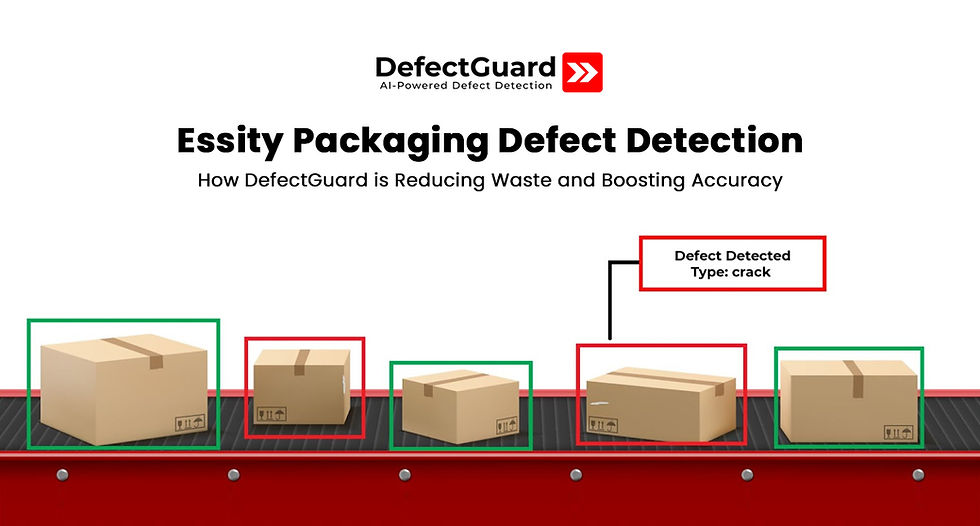Smarter Quality Control: How AI-Powered Vision Systems are Reshaping Defect Detection in Manufacturing
- pyadav52
- Apr 17
- 3 min read
In today’s high-speed manufacturing environment, delivering consistent product quality while minimizing downtime and waste is a constant challenge. Traditional inspection methods can’t always keep up with the scale, precision, and speed required. That’s where AI-powered vision inspection systems come in — transforming quality inspection, loss prevention, and safety detection across modern factory and manufacturing settings.
The Rise of Computer Vision in Manufacturing
Computer vision technology uses advanced algorithms and cameras to inspect products in real time. When paired with artificial intelligence (AI) and machine learning, it not only detects defects but also continuously learns and improves from each inspection.
From identifying tiny imperfections in bearings to spotting corrosion or dents on metal surfaces, AI-based visual inspection offers unparalleled accuracy and speed.
Key Areas Where AI-Powered Defect Detection Is Making an Impact
1. Bearing Defect Detection
Bearings are critical components in machinery, and even minor flaws can cause performance degradation or unexpected breakdowns. AI-enabled bearing defect detection systems can identify:
Surface wear or pitting
Cracks
Misalignment
Overheating patterns
By using infrared and high-resolution imaging, manufacturers can prevent costly equipment failures and optimize maintenance schedules.
2. Corrosion Detection
Corrosion can compromise the integrity of metal structures and components. Traditional methods often rely on manual checks, which can miss early signs of degradation.
With AI-based corrosion detection, manufacturers can:
Detect corrosion in real time
Monitor hard-to-reach areas using drones or robotic arms
Predict and prevent long-term material damage
This proactive approach enhances safety, extends the life of machinery, and supports compliance in regulated industries.
3. Can Defect Detection
In the food and beverage industry, packaging plays a vital role in quality assurance and consumer safety.
AI vision systems are used to inspect:
Dent marks or bulges on cans
Improper sealing
Label misplacement
Barcode errors
Fast and reliable can defect detection reduces waste, minimizes recalls, and ensures product integrity before it reaches the consumer.
Enhancing Safety Detection in Manufacturing Environments
Beyond product inspection, computer vision is also a game-changer for workplace safety.
AI-powered safety detection systems can:
Monitor employee movements in restricted zones
Detect missing personal protective equipment (PPE)
Identify dangerous spills or obstructions on factory floors
Trigger real-time alerts for accidents or unsafe behaviors
By integrating safety detection into the production process, manufacturers can reduce workplace incidents and comply with safety regulations more effectively.
Preventing Loss Through Visual Quality Inspection
Loss prevention in manufacturing isn’t just about shrinkage — it includes loss of materials, time, and productivity.
Smart visual inspection systems prevent losses by:
Catching defects before products leave the line
Reducing rework and waste
Lowering return rates from customers
Ensuring compliance with quality standards
AI algorithms can be trained to detect subtle changes that human inspectors might miss, helping businesses maintain consistent quality at scale.
Integrated Quality Inspection with AI: From Manual to Smart
Traditional quality inspection is time-consuming and inconsistent.
AI brings scalability and consistency to the process, with benefits including:
24/7 Inspection: AI doesn't fatigue and can operate continuously.
Speed & Accuracy: Processes thousands of units per minute with high precision.
Data-Driven Insights: Automatically logs inspection data for continuous improvement and root cause analysis.
Integration with ERP/SCM: Seamlessly connects with systems like Microsoft Dynamics 365 for real-time decision-making.
A Look Into the Future: AI and Vision Inspection Working Together
As manufacturers move towards Industry 4.0, vision inspection and defect detection will play a central role in digital transformation.
Companies that invest in AI-driven inspection tools can expect:
Lower defect rates
Higher customer satisfaction
Faster time to market
Greater operational efficiency
Whether you’re dealing with corrosion on metal parts, bearing fatigue, can packaging issues, or factory floor safety, an integrated AI solution can address them all through a single platform.
Why Brightpoint AI?
At Brightpoint AI, we specialize in AI-powered defect detection and visual inspection for a wide range of manufacturing needs — from bearing analysis and corrosion detection to can inspections, safety monitoring, and loss prevention.
Our expertise in computer vision and AI automation enables manufacturers to:
Improve quality and throughput
Reduce downtime and losses
Enhance safety in production environments
Whether you're in textiles, F&B, automotive, or heavy industry, we offer tailored solutions that are smart, scalable, and easy to integrate.
Ready to Automate Quality Inspection and Safety Monitoring?
Explore our AI-powered defect detection solutions
Reduce losses and improve factory safety Partner with Brightpoint AI for reliable
visual inspection technology
Contact Brightpoint AI to schedule a free consultation and see how we can help you transform your manufacturing operations with AI
Final Thoughts
AI-powered defect detection and quality inspection are not just innovations — they’re becoming essential for modern manufacturing.
From preventing product defects to enhancing safety and ensuring compliance, these systems drive real results.
By combining computer vision, machine learning, and real-time analytics, manufacturers can take a proactive approach to quality control, loss prevention, and safety monitoring — ensuring a smarter, safer, and more efficient production environment.









Comments